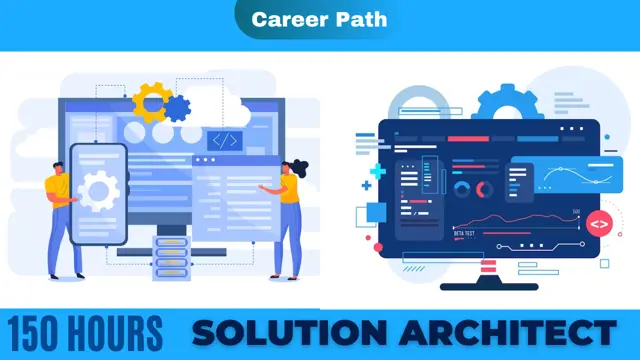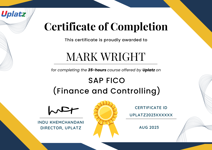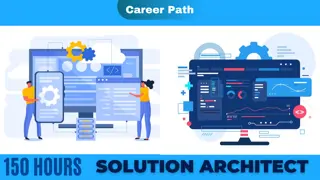
Solution Architect Career Path
Self-paced videos, Lifetime access, Study material, Certification prep, Technical support, Course Completion Certificate
Uplatz
Summary
- Uplatz Certificate of Completion - Free
Add to basket or enquire
Overview
Uplatz provides this powerful and extensive Career Path program to help you become a Solution Architect. It is a program covering all topics related to Designing Solution Architecture in the form of self-paced video tutorials. You will be awarded Course Completion Certificate at the end of the course.
The following courses are included in the Solution Architect Career Path:
- SQL Programming
- Oracle PL/SQL
- Business Intelligence and Data Analytics
- Talend
- Power BI
- Tableau
- Python Programming
- R Programming
- Java Programming
- JavaScript Programming
- React Programming
- Introduction to DevOps
- Git and GitHub
- Cloud Computing Basics
- Microsoft Azure
- AWS (coming soon)
- API Design & Development
- Software Testing
- Cybersecurity
- Leadership and Management
- Project Management Fundamentals
A Solution Architect is a role in the field of information technology and software development. The primary responsibility of a Solution Architect is to design and create solutions for complex business problems or technical challenges. These professionals bridge the gap between business requirements and technical specifications, ensuring that the final solution aligns with the organization's goals and objectives.
Key responsibilities of a Solution Architect include:
Requirement analysis: Understanding the business needs and technical requirements of a project or system, often through collaboration with stakeholders and subject matter experts.
Solution design: Creating a comprehensive plan or blueprint that outlines the structure, components, and interactions of the solution. This includes selecting appropriate technologies, platforms, and tools to meet the project's needs.
Architecture modeling: Developing models, diagrams, and prototypes to visualize and communicate the proposed solution architecture to stakeholders.
Integration and scalability: Ensuring that the solution is designed in a way that allows for easy integration with existing systems and can scale to accommodate future growth and changes.
Security and compliance: Addressing security concerns and ensuring that the solution complies with industry standards and regulations.
Performance optimization: Identifying potential bottlenecks and areas for performance improvement within the solution.
Collaboration: Working closely with development teams, project managers, business analysts, and other stakeholders throughout the project lifecycle.
Documentation: Preparing detailed technical documentation for developers and other team members to implement the solution effectively.
Risk management: Identifying and mitigating potential risks that could impact the success of the solution.
Continuous improvement: Staying up-to-date with the latest technologies and industry trends to suggest improvements or enhancements to existing systems.
The Solution Architect role requires a deep understanding of various technologies, architectural patterns, and best practices in software development and system design. They also need excellent communication and interpersonal skills to interact with different stakeholders effectively. Additionally, they should possess problem-solving abilities to address complex challenges that arise during the project's lifecycle.
Course media
Description
How to become a Solution Architect?
Becoming a Solution Architect requires a combination of technical expertise, business acumen, and strong communication skills. Solution Architects play a crucial role in designing and implementing complex IT solutions that align with business objectives. Here are the steps to become a Solution Architect:
Educational Background: Start by earning a bachelor's degree in computer science, software engineering, information technology, or a related field. A solid educational foundation in these areas will help you understand the technical aspects of solution architecture.
Gain Relevant Experience: Solution Architects typically have several years of experience in software development, systems analysis, or related roles. Work in roles such as software engineer, developer, or system analyst to gain hands-on experience with various technologies and platforms.
Develop Technical Skills: Acquire expertise in a wide range of technologies, including programming languages, databases, cloud computing, networking, security, and more. Stay updated with the latest developments in the tech industry.
Understand Business Requirements: Solution Architects need to bridge the gap between business needs and technical solutions. Develop your business acumen by understanding how businesses operate, their goals, challenges, and industry-specific requirements.
Improve Soft Skills: Communication, leadership, and teamwork are essential for a Solution Architect. Enhance your ability to communicate technical concepts to non-technical stakeholders, lead discussions, and collaborate effectively with cross-functional teams.
Obtain Relevant Certifications: Seek certifications in relevant technologies and frameworks, such as cloud certifications (e.g., AWS Certified Solutions Architect, Microsoft Azure Architect, Google Cloud Architect), IT service management (e.g., ITIL), or enterprise architecture (e.g., TOGAF).
Work on Real Projects: Participate in real-world projects that involve designing and implementing solutions. Engage with senior Solution Architects and mentors to learn from their experiences.
Network and Learn from Others: Attend industry events, conferences, and webinars to network with professionals in the field. Join architecture-focused communities and online forums to learn from experienced Solution Architects and share knowledge.
Get Involved in the Design Process: Collaborate with Solution Architects and cross-functional teams during the design phase of projects. Learn how architectural decisions impact overall project success and business outcomes.
Continuously Learn and Adapt: The technology landscape is constantly evolving, and Solution Architects must adapt to new trends and emerging technologies. Stay curious, continuously learn, and explore new tools and approaches.
Seek Leadership Opportunities: Demonstrate leadership skills by taking ownership of projects and leading teams. Leadership experience is valuable for advancing into higher-level Solution Architect roles.
Remember that becoming a Solution Architect is a journey that requires dedication, a passion for technology and problem-solving, and a commitment to lifelong learning. As you gain experience and build a strong track record of successful solution implementations, you'll be better positioned to advance your career as a Solution Architect.
The career path of a Solution Architect typically follows a progression of increasing responsibility and complexity of projects. It may vary depending on the organization's structure, industry, and individual aspirations. Here is a common career path for a Solution Architect:
Junior/Associate Solution Architect: As a Junior or Associate Solution Architect, you will work under the guidance of more experienced architects and be involved in smaller projects or specific components of larger solutions. You will learn the ropes and gain practical experience in solution design and implementation.
Solution Architect: After gaining a few years of experience as an Associate, you will advance to a Solution Architect role. In this capacity, you will be responsible for leading the design of entire solutions, collaborating with stakeholders, understanding business needs, and translating them into architectural blueprints.
Senior Solution Architect: With several years of successful solution design and implementation experience, you can progress to a Senior Solution Architect role. At this level, you will handle more complex and critical projects, oversee other architects or project teams, and provide guidance on architectural decisions.
Lead Solution Architect: As a Lead Solution Architect, you will take on more significant leadership responsibilities, coordinating the work of multiple Solution Architects or project teams. You will be involved in strategic planning and alignment of architecture initiatives with organizational goals.
Enterprise/Chief Architect: Some Solution Architects advance to Enterprise or Chief Architect roles, where they are responsible for the overall architecture vision and strategy of the entire organization. They work closely with business executives, IT leadership, and other stakeholders to ensure alignment between technology and business objectives.
Consulting/Principal Architect: In consulting firms or larger organizations, experienced Solution Architects may take on Consulting or Principal Architect roles. These positions involve providing architectural expertise to clients, leading large-scale projects, and driving innovation in solution design.
Architecture Leadership: Depending on the organization's structure, experienced Solution Architects can move into roles such as Architecture Manager, Architecture Director, or Head of Architecture. These positions involve overseeing the entire architecture practice within the organization, including talent development, best practices, and technology standards.
It's important to note that the career path of a Solution Architect is not always linear, and there may be opportunities for specialization in specific domains or technologies. Additionally, Solution Architects can choose to work in specific industries or focus on emerging technologies like cloud computing, artificial intelligence, or cybersecurity.
To progress in your career as a Solution Architect, it's essential to continuously update your technical skills, stay abreast of industry trends, develop your leadership and communication abilities, and actively seek opportunities to take on more significant and challenging projects. Building a strong portfolio of successful solution implementations and networking with industry professionals can also contribute to career advancement.
Who is this course for?
Everyone
Requirements
Enthusiasm and passion to learn and succeed!
Career path
- Solution Architect
- Lead Solution Architect
- Enterprise Architect
- Principal Architect
- Engineering Lead
- Engineering Manager
- Head of Architecture
- Chief Technology Officer (CTO)
- Chief Data Officer (CDO)
Questions and answers
Currently there are no Q&As for this course. Be the first to ask a question.
Certificates
Uplatz Certificate of Completion
Digital certificate - Included
Course Completion Certificate by Uplatz
Reviews
Currently there are no reviews for this course. Be the first to leave a review.
Legal information
This course is advertised on reed.co.uk by the Course Provider, whose terms and conditions apply. Purchases are made directly from the Course Provider, and as such, content and materials are supplied by the Course Provider directly. Reed is acting as agent and not reseller in relation to this course. Reed's only responsibility is to facilitate your payment for the course. It is your responsibility to review and agree to the Course Provider's terms and conditions and satisfy yourself as to the suitability of the course you intend to purchase. Reed will not have any responsibility for the content of the course and/or associated materials.



